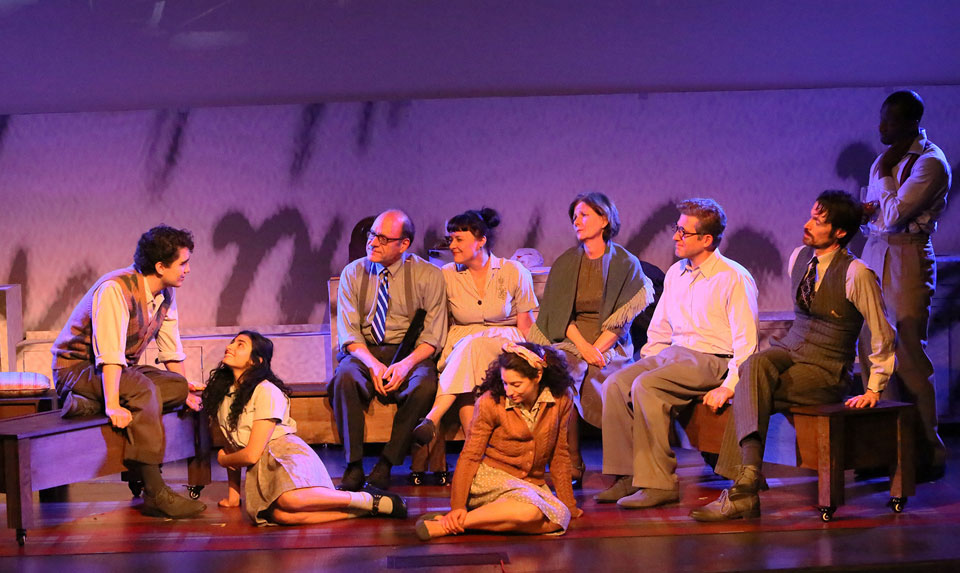
LOS ANGELES—Had the teenage Anne Frank managed to hold her breath just a couple of weeks more until the liberation of the Bergen-Belsen concentration camp by the Allies, she might have lived out a long life not only comfortably cushioned by the royalties from her world-famous, best-selling post-war publication of The Diary of a Young Girl but also by the renown she would have earned from her later writings as well. Today, at 90, she’d be a still feisty observer and commentator on the human condition, and one of the last Holocaust survivors around. You might catch her on one of her talks to school children at the Simon Wiesenthal Center’s Museum of Tolerance here, explaining to kids who never could imagine such horrors what it was like to live them.
In celebration of what would have been her 90th birthday this month (June 12), the Simon Wiesenthal Center presents the U.S. premiere of Anne, A New Play, a fresh interpretation of the diary written by Dutch playwrights Jessica Durlacher and Leon de Winter. In this version, the authors reframe Anne’s story through an unconventional lens: The budding writer and memoirist did not die of typhus at 15, but is seated at a Paris bistro table, hungry but safe as the world recovers from war and loss. A man watches her intently writing and introduces himself as a publisher who would like to see her manuscript when it is ready. For the next fast-paced 80 minutes we see her story enacted in her mind as she relates it to the publisher who, unseen by anyone else, remans onstage amidst her characters.
Anne Frank is in all probability the most famous teenage author in literature. Her Diary found readers in every land, beginning with its first publication in 1947. The journal had miraculously survived. In the immediate family, only her father Otto was left, and it was he who ushered the book into the literary stratosphere. It became an instant hit especially among young readers who could identify with her awakening maturity under the worst conceivable conditions.
For a modern audience it is a welcome addition to insert the publisher into the play as a character, for we want to enter the story 75-plus years after the fact, at a time when the collective memory of those events has long faded. It’s lamentable to think that billions of people in the world know nothing about the Holocaust.
“I don’t want to have lived in vain,” Anne wrote. “I want to be useful of bringing enjoyment to all people, even those I’ve never met. I want to go on living even after my death.” The newly written play surely will help that to happen.
It’s fitting that the U.S. premiere is taking place at the Simon Wiesenthal Center, named for the famous Nazi hunter. As recounted by Rabbi Marvin Hier, founder and dean of the Center, “Simon never forgot Anne Frank. On his desk when he died, was the newspaper article of the capture of the man who arrested her. Of the many Nazis he brought to justice he was most proud of finding the Nazi who arrested Anne Frank, because to him she best represented what the world lost by the murder of six million Jews.”
The Durlacher-de Winter play (seen June 16) has been newly adapted for American audiences by Nick Blaemire from a translation by Susan Massotty and is directed by Eve Brandstein, daughter of Holocaust survivors. It premiered in Amsterdam in 2014. Durlacher’s grandfather perished in Bergen-Belsen and was there with Anne Frank. De Winter, married to Durlacher, also lost about 100 relatives in the Holocaust.
Critics have praised this version of the story for presenting Anne as “somewhat impetuous, spoiled and lonely” (New York Times), finding the more familiar version that is often staged substantially more sanitized and simplistic. The Anne Frank Foundation is interested in making Anne more interesting to later generations.
Desma Murphy’s set design recreates the cramped attic where the Frank and van Pels families crowded together, joined by Dr. Pfeffer. Movable units serve as seating, beds, even a makeshift toilet. Florence Kemper Bunzel’s costumes summon up both the era and the personalities of Anne’s companions in hiding as they struggle to preserve their sanity. Projections and sound fill out the modestly dressed stage.
“These historical figures are our better angels,” says Blaemire. “The play is about what we can all do for each other, and how we can live up to Anne’s story—to make sure that it never happens again.” One would hope that seeing this play, theatergoers could also give some thought to children in Yemen, in the Rohingya camps in Southeast Asia, in the open-air concentration camp that is Gaza today, to the fields, factories and forests where youngsters are forced to labor, and to those infants and toddlers caged and dying in detention centers on our own borders.
The star of the show—and is she ever a star!—is the amazing Ava Lalezarzadeh, currently in her third year at UCLA’s School of Theater, Film and Television. She is Anne in all her adolescent longing, moodiness and vivacity, her confidence in humanity, her emerging physicality and sensuality. Her own parents escaped from Iran in the 1980s, so she is deeply conscious of anti-Jewish persecution. Rob Brownstein plays her patient, loving father Otto, and Andrea Gwynnel performs as Edith, her mother, with whom she frequently clashes emotionally. Anne’s older sister Margot is played by Marnina Schon.
Other characters in the attic include Hermann van Pels (Aylam Orian) and Auguste van Pels (Mary Gordon Murray), and their teenage son Peter (Kevin Matsumoto), for whom Anne develops a crush. Tony DeCarlo plays the intrusive Dr. Pfeffer. Timothy P. Brown is featured as the big-hearted fictional publisher. Thoughtful use of blind casting for some of these roles opens up the story to broader audiences as well as to wider relevance. Blaemire says, “It’s about us, all of us.”
Audiences seeing Anne, A New Play can also see the Anne Frank Exhibit currently on display at the museum. Narrated by actress Hailee Steinfeld, this newest of the museum’s offerings brings Anne’s story to life through immersive environments, multimedia presentations and intriguing displays.
Anne, A New Play runs through July 22 with performances on Sun. at 3 and 7 pm and Mon. at 8 pm. It is appropriate for ages 8 and up. The Museum of Tolerance is located at 9786 W Pico Blvd., Los Angeles 90035. Parking is free in the underground structure. For reservations and information, call (310) 772-2505 or go to www.museumoftolerance.com.










